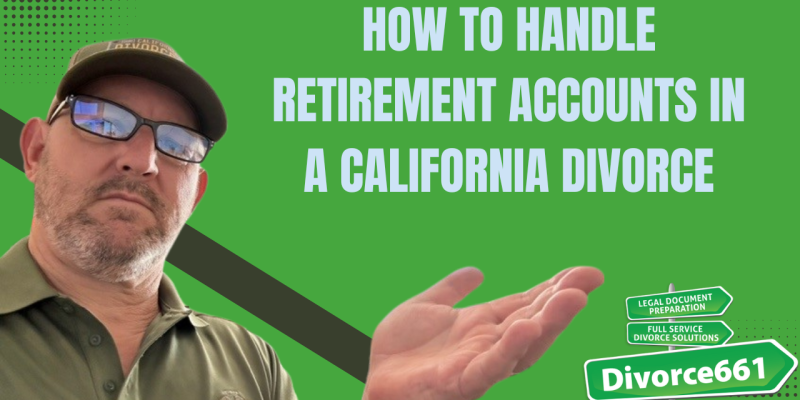How to Handle Retirement Accounts in a California Divorce
Introduction
I’m Tim Blankenship from Divorce661. If you’re navigating a divorce in California, one of the most misunderstood—and potentially costly—areas is dividing retirement accounts. Retirement earned during the marriage is community property, but dividing it properly requires more than a simple line in your settlement. In this article I’ll explain what you need to know about Qualified Domestic Relations Orders (QDROs), common pitfalls, a real-life example, and practical next steps to protect your retirement assets.
Why retirement accounts deserve special attention
Retirement assets like 401(k)s and pensions are often among the largest marital assets. While California treats retirement earned during the marriage as community property (usually split 50/50), the mechanics of dividing those accounts are governed by federal rules and plan documents. If you don’t follow the right legal steps, you can trigger taxes, early-withdrawal penalties, or simply be unable to get the other spouse’s share out of the plan.
Key points to remember
- Community property: Retirement earned during the marriage is generally community property in California and is subject to division.
- You can’t just “agree to divide it” in your judgment: Many plans require a formal court order and specific language before they will permit division.
- QDROs are often required: For ERISA-covered plans (typical employer 401(k)s and many pensions) a QDRO is the formal tool that allows the plan administrator to pay a non-employee spouse without triggering taxable distributions.
“You can’t just ‘agree to divide it’ in your paperwork.”
What is a QDRO (Qualified Domestic Relations Order)?
A QDRO is a court order that recognizes the right of a spouse (or other dependent) to receive a portion of retirement benefits from an ERISA-covered plan. It tells the plan administrator exactly how to split and pay out the benefits. Without an approved QDRO, the plan may refuse to honor the division, and attempting to withdraw funds without one can create unwanted tax consequences.
When is a QDRO required?
- ERISA plans: Most employer-sponsored pension plans and 401(k)s are subject to ERISA and typically require a QDRO to divide benefits.
- Defined benefit plans (pensions): Almost always require a QDRO.
- Defined contribution plans (401(k)/403(b)): Usually require a QDRO.
- IRAs: Generally not ERISA plans, so a QDRO is usually not necessary. IRAs are commonly divided by a transfer-incident-to-divorce under tax code rules, which still requires appropriate court language but follows a different process.
Common mistakes to avoid
- Putting vague language in your judgment that simply says assets will be split without specifying QDRO requirements or how the division will be implemented.
- Assuming the plan administrator will automatically divide the account based on the divorce judgment without an approved QDRO.
- Withdrawing funds directly to split them—this can trigger taxes and early withdrawal penalties.
- Waiting until after the divorce is final to start the QDRO process—some plans have approval requirements that can take time.
A real-life example
We recently helped a couple who had agreed to split a pension and a 401(k). They thought that putting the agreement into their divorce paperwork was enough. They didn’t realize a QDRO was required for the pension and 401(k). We added the correct QDRO language to their judgment and worked with a QDRO attorney to prepare and submit the QDRO for plan approval. The result: the plan approved the QDRO, the accounts were divided without tax penalties, and both parties received the retirement shares they were entitled to.
How the QDRO process typically works
- Identify which plans are subject to ERISA and which are IRAs or other non-ERISA plans.
- Include clear, specific QDRO language in your divorce judgment or settlement so the division is authorized by the court.
- Have a QDRO-drafting professional or attorney prepare the QDRO. Plan administrators often have sample language or specific requirements—those must be followed.
- Submit the QDRO to the plan administrator for pre-approval (some plans require this) and then obtain final court approval and signature.
- Once approved by the plan, the funds are transferred according to the order.
Practical tips to protect your retirement during divorce
- Don’t cash out retirement funds to split them—explore transfers or QDROs instead to avoid taxes and penalties.
- Get plan documents early so you know the rules and any administrative requirements or fees.
- Document the dates and amounts of contributions made during the marriage—these details matter for valuation and apportionment.
- Work with professionals: a family law attorney, a QDRO specialist, and a financial advisor can help prevent costly mistakes.
- Include explicit QDRO language in your divorce paperwork so one more hurdle is removed in the post-judgment process.
How Divorce661 can help
At Divorce661 we make sure your divorce paperwork includes the correct QDRO language so the division of retirement accounts is done right the first time. When a QDRO is required, we connect clients with trusted QDRO professionals and coordinate the process so your retirement is protected and tax issues are avoided.
Conclusion and next steps
Dividing retirement accounts in a California divorce is not just a matter of agreeing to split—it’s a technical process that often requires a QDRO for ERISA plans and careful handling for IRAs. By understanding the rules and taking the right steps, you can avoid tax penalties, administrative headaches, and delays.
If you’re dividing retirement accounts in your California divorce, take action early: review plan documents, include clear QDRO language in your judgment, and work with experienced professionals to prepare and approve the necessary orders. For a free consultation and help getting this right, visit Divorce661.com and schedule a time to talk.

